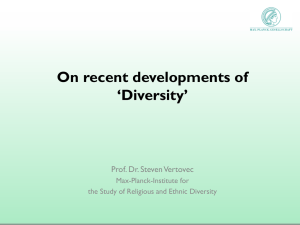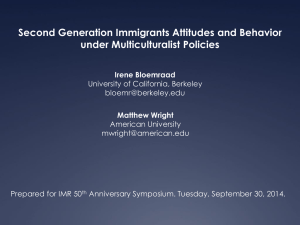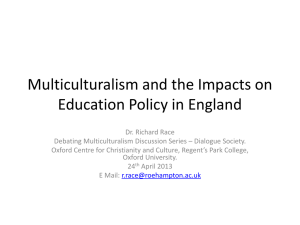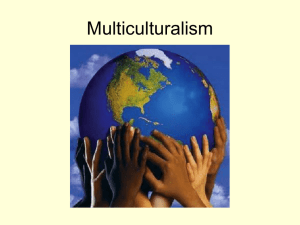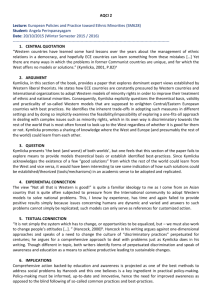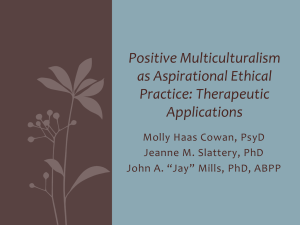Multiculturalism
advertisement
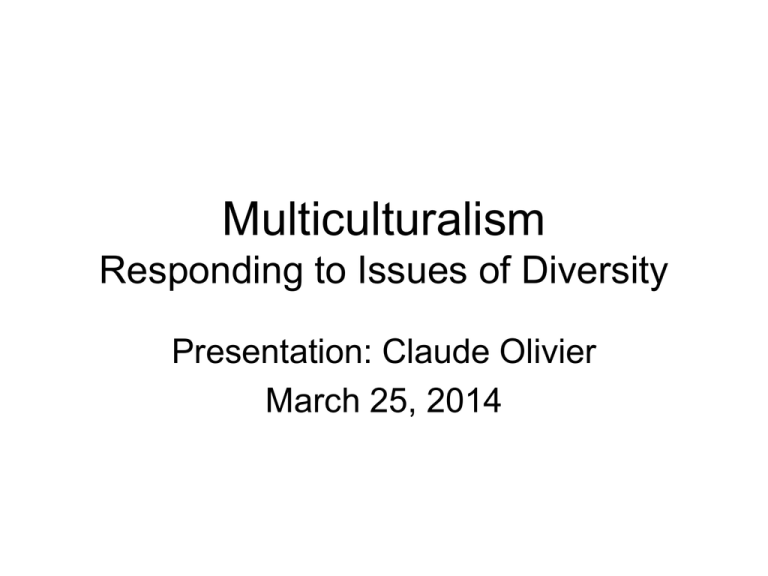
Multiculturalism Responding to Issues of Diversity Presentation: Claude Olivier March 25, 2014 Multiculturalism Primarily from: • Kymlicka, W. (2008). Multiculturalism, social justice and the welfare state. In G. Craig, T. Burchardt, & D. Gordon (Eds.), Social justice and public policy: Seeking fairness in diverse societies (pp. 53-75). Bristol, UK: The Policy Press. Multiculturalism What is it? • Recognition and promotion of diversity within society and its institutions (versus requiring minority groups to conform or assimilate into a dominant culture) • Can you think of examples where we recognize and/or promote cultural diversity within our social institutions? • Multiculturalism (Kymlicka, 2008) rejects “earlier models of the unitary, homogenous nation state” (p. 54);and processes of assimilation and exclusion to attain national homogeneity • Can you think of examples of government policies that have been used to impose the dominant group’s culture? Policies that have been used to impose dominant group’s position (Kymlicka, 2008, p. 55) • “official language laws” • “compulsory education promoting a standardized curriculum” • “centralization of political power” (versus local autonomy of minority groups) • diffusion of dominant culture and language “through national cultural institutions” (media, museums) • “adoption of state symbols celebrating the dominant” group • “unified legal and judicial system” • “settlement policies that encourage members of dominant group to settle in areas where minority groups” reside • immigration policies with language requirements (of dominant group) • declaring natural resources “that used to belong to minority groups” as national resources • Such policy direction can result in… “multiple and deeply-rooted forms of exclusion and subordination for minorities” (Kymlicka, 2008, p. 56). • “As a result, various sub-state groups…have advocated instead for a more multicultural state” (Kymlicka, 2008, p. 56). Kymlicka identifies (2008, pp. 56-57) three principles common to multicultural states: • 1) reject idea of state as “possession of a single national group” (p. 56) • 2) reject nation-building policies when aim is to assimilate or exclude members of non-dominant group but rather support social inclusion without needing to deny ethnocultural identity • 3) acknowledge historic injustice to minority groups by policies of assimilation and exclusion, and offer rectification Kymlicka (2008) illustrates approaches to multiculturalism in relation to 3 key groups. • 1) Indigenous peoples: distinct societies, land claims, cultural rights, self-government. • 2) Sub-state nationalisms: “nations within a larger state” (p. 58), self-government at subfederal level, official language/cultural rights. • 3) Immigrant groups: “race-neutral admissions criteria” (p. 59), multicultural approach to integration versus assimilation. Multiculturalism What is its history in Canada? • In 1971, the federal government took position that Canada would adopt a multicultural policy (e.g., recognize and respect diversity of languages, customs, religions) • 1982; Section 27 of the Canadian Charter of Rights and Freedoms requires the Charter to be interpreted in a multicultural context • The Canadian Multiculturalism Act enacted in 1988 The Canadian Multiculturalism Act states that it is the policy of the Government of Canada to: (10 clauses; a-j) • (a) recognize and promote the understanding that multiculturalism reflects the cultural and racial diversity of Canadian society and acknowledges the freedom of all members of Canadian society to preserve, enhance and share their cultural heritage [so recognizes and promotes Canada’s multicultural heritage] • (e) ensure that all individuals receive equal treatment and equal protection under the law, while respecting and valuing their diversity Multiculturalism Act cont. • (f) encourage and assist the social, cultural, economic and political institutions of Canada to be both respectful and inclusive of Canada’s multicultural character [promotes recognition in our institutions] • (i) preserve and enhance the use of languages other than English and French, while strengthening the status and use of the official languages of Canada [recognizes English and French as official languages but also use of other languages; so preserves aspect of dominant culture] (Government of Canada, Justice Laws website) Can multiculturalism truly exist in our society? It may be a matter of degrees; at one end of the multicultural continuum is: • Social structures such as public institutions reflect the dominant culture then accommodation is made for minority groups At other end of multicultural continuum is: • An ideology that recognizes and affirms all cultural diversities and does not preserve or advantage any single one Challenges: a dynamic tension • I think the main issue is implementing multicultural policy where aspects of the dominant culture are preserved or privileged, while affirming the cultural identities of minority groups through accommodation. • And the state needs to be very careful about reasons for not providing accommodation. Quebec Charter of Values provides a current example of this tension: • The proposed charter: Bill 60, Charter affirming the values of State secularism and religious neutrality and of equality between women and men, and providing a framework for accommodation requests (Quebec Official Publisher, 2013). • The proposed charter protects some important facets of Canadian culture and values, such as the equality between women and men, and religious neutrality or the separation of religions and state. Quebec Charter of Values cont. • Where it is viewed by some as unnecessarily restrictive (and going against principles of multiculturalism) is the section that prohibits public sector employees from wearing “objects such as headgear, clothing, jewelry or other adornments which, by their conspicuous nature, overtly indicate a religious affiliation” (Bill 60, 2013, p. 6) • In contrast, in 1990 the federal government lifted ban on RCMP members wearing a turban (in response to challenge by person of Sikh religion). Kymlicka (2008) identifies two concerns related to multiculturalism and the welfare state: Concerns are based on premise that “multiculturalism policies are undermining the national identities and solidarities that have historically sustained the welfare state” (pp. 61-62) 1) The heterogeneity/redistribution trade-off hypothesis • Posits that diversity may make it harder for people to come together and form a national solidarity and support redistribution of wealth associated with welfare state. • Although there is some evidence to suggest this is true; Kymlicka concludes there is need for more research before drawing a definitive conclusion. He also points out that there is no evidence to suggest that countries with large foreign-born populations spend less on social programs than countries with small immigrant populations (p. 68) or that support for welfare state policies is eroded (p. 69). 2) The recognition/redistribution trade-off hypothesis • Posits that multicultural policies themselves undermine national solidarity by emphasizing ethnic difference rather than national commonalities. • Reasons speculated: – 1. Weaker solidarity among citizens – 2. Diverts attention from other policy approaches – 3. Draws attention away from ‘real’ problems such as racism and class division Recognition/redistribution hypothesis cont. • To test out this hypothesis, Kymlicka and colleagues were able to rate countries related to having adopted strong multicultural policies such as their approach to immigrant integration (listed below). • Kymlicka (2008) concludes “we have found no support for the claim that there is an inherent trade-off between policies of ethnocultural recognition and economic redistribution” (p. 71), or that multiculturalism undermines support for redistribution. Policies common of a ‘multicultural’ approach to immigrant integration: • “constitutional, legislative or parliamentary affirmation of multiculturalism; • the explanation/celebration of multiculturalism in the school curriculum; • the inclusion of ethnic representation/sensitivity in the mandate of public media; • exemption from dress codes, Sunday-closing legislation and so on; • allowing dual citizenship; • the funding of ethnic group organizations or activities; • the funding of bilingual education or mother-tongue instruction; and • affirmative action for disadvantaged immigrant groups.” (Kymlicka, 2008, pp. 69-70) The benefits of Multiculturalism • Perhaps the benefits are best identified in comparison to older models of organizing societies, such as the notion of a homogenous state with public policies that resulted in assimilation and exclusion of minority groups. • So can make a social justice argument for multiculturalism. • Are there better alternatives to responding to the reality of a diverse society? Your thoughts? References • Government of Canada, Justice Laws Website, Canadian Multiculturalism Act. • Kymlicka, W. (2008). Multiculturalism, social justice and the welfare state. In G. Craig, T. Burchardt, & D. Gordon (Eds.), Social justice and public policy: Seeking fairness in diverse societies (pp. 53-75). Bristol, UK: The Policy Press. • Quebec Official Publisher. (2013). Bill 60, Charter affirming the values of State secularism and religious neutrality and of equality between women and men, and providing a framework for accommodation requests (Quebec Official Publisher, 2013).

